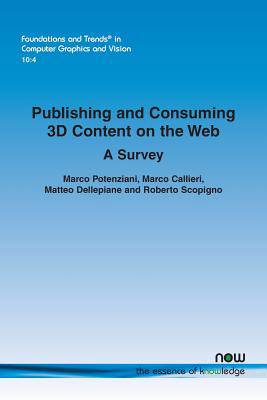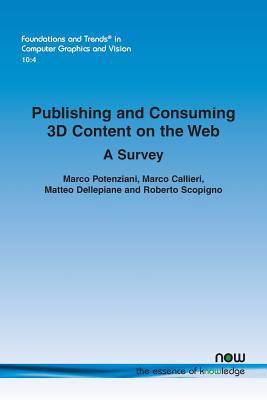
Door een staking bij bpost kan je online bestelling op dit moment iets langer onderweg zijn dan voorzien. Dringend iets nodig? Onze winkels ontvangen jou met open armen!
- Afhalen na 1 uur in een winkel met voorraad
- Gratis thuislevering in België vanaf € 30
- Ruim aanbod met 7 miljoen producten
Door een staking bij bpost kan je online bestelling op dit moment iets langer onderweg zijn dan voorzien. Dringend iets nodig? Onze winkels ontvangen jou met open armen!
- Afhalen na 1 uur in een winkel met voorraad
- Gratis thuislevering in België vanaf € 30
- Ruim aanbod met 7 miljoen producten
Zoeken
Publishing and Consuming 3D Content on the Web
A Survey
Marco Potenziani, Marco Callieri, Matteo Dellepiane, Roberto Scopigno
€ 82,45
+ 164 punten
Omschrijving
Recently tools such as 3D printing, 3D viewers, and editing systems embedded in common operating systems have seen 3D data evolve from specialized content, used by a few professionals, to completely integrated web content used by many internet users. These new trends are pushing 3D content towards ubiquitous use, whereby data management, user interactions, and crossmedia integration are open issues still to be solved. The growth in widely available tools for 3D web content has given rise to complicated situations for those developers and users with a poor awareness of the peculiar needs of each specific combination of 3D data and application domain requirements. This monograph presents a comprehensive survey of the currently available Web3D tools and their applications. The authors define a schema of the available possibilities and features supported by enabling technologies and implemented systems. This results in providing a roadmap that, depending on the application field, navigates the user through the technical characteristics needed to build an efficient and effective Web3D presentation. Publishing and Consuming 3D Content on the Web will be of interest to all readers wishing to master the concepts which characterize the different phases of the Web3D publishing process.
Specificaties
Betrokkenen
- Auteur(s):
- Uitgeverij:
Inhoud
- Aantal bladzijden:
- 100
- Taal:
- Engels
- Reeks:
- Reeksnummer:
- nr. 31
Eigenschappen
- Productcode (EAN):
- 9781680835366
- Verschijningsdatum:
- 13/12/2018
- Uitvoering:
- Paperback
- Formaat:
- Trade paperback (VS)
- Afmetingen:
- 156 mm x 234 mm
- Gewicht:
- 158 g

Alleen bij Standaard Boekhandel
+ 164 punten op je klantenkaart van Standaard Boekhandel
Beoordelingen
We publiceren alleen reviews die voldoen aan de voorwaarden voor reviews. Bekijk onze voorwaarden voor reviews.











